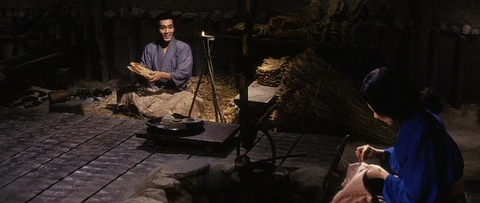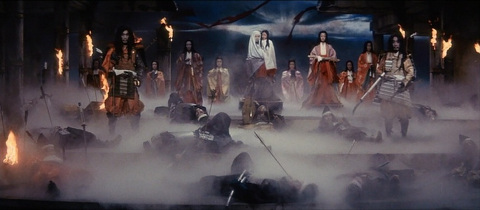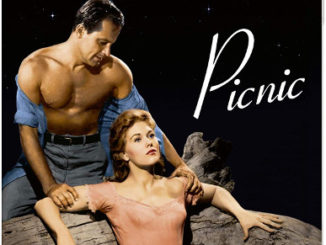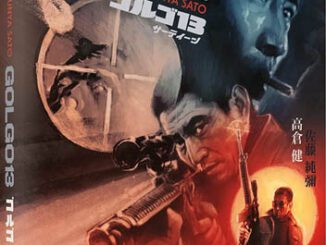Kwaidan (1964)
Directed by: Masaki Kobayashi
Written by: Lafcadio Hearn, Yoko Mizuki
Starring: Kanemon Nakamura, Kazuo Nakamura, Keiko Kishi, Rentari Mikuni
JAPAN
AVAILABLE ON BLU-RAY: 27TH APRIL, from EUREKA ENTERTAINMENT
RUNNING TIME: 183 mins/ 160 mins/ 125 mins
REVIEWED BY: Dr Lenera
FOUR TALES…..
THE BLACK HAIR
An impoverished swordsman divorces his wife, a weaver, and leaves her for a woman of a wealthy family to attain greater social status. However, his new wife turns out to be callous and selfish, and the swordsman begins to regret leaving his more devoted and patient ex-wife and thinks about returning to her….
THE WOMAN IN THE SNOW
Two woodcutters, Minokichi and Mosaku, are trudging through a snowy forest when they come across a ghostly woman who kills Mosaku and leaves Minokichi alive on the condition that he never tell a living soul about their encounter. He then falls in love with and marries the forever youthful Yuki, and begins to wonder whether the incident in the forest ever happened….
HOICHI THE EARLESS
Hoichi is a young blind singer/storyteller who’s relating of a saga of warring clans so impresses a ghost emperor that he’s repeatedly summoned to perform for him, a demand which takes a toll on Hoichi’s own spirit. His friends drag him home on the last night before his performance is completed but he’s now in great danger, so the local priests cover him with painted holy symbols which will render him invisible to the ghosts….
IN A CUP OF TEA
Sekinai is an attendant to Lord Nakagawa Sadono. When Sadano, en route to a New Year’s visit, halts with his entourage at a tea-house, Sekinai sees the face of a young man in a cup of tea. Despite being perturbed, he drinks the cup. Later on the man reappears in full, calling himself Heinai Shikibu. Sekinai tell the other attendants, but they don’t believe him….
I’m ashamed to say that, while I’d certainly heard of it, I didn’t know very much about Kwaidan, Japan’s best known ghost movie up to 1998’s Ringu, until now, and what I did know mostly involved the third of its four stories Hoichi The Earless, its vicious ending being oft told in books about horror movies I read when I was young, books that described these amazing films that I wasn’t old enough to see. Fast forward to much more recently, and I did almost buy Criterion’s Region ‘A’ Blu-ray of Kwaidan, but its considerable cost held me back from purchasing a movie which I felt would have considerable aesthetic merit but would probably be rather remote and distant, a film more to admire than to enjoy. But just a few minutes into Kwaidan, courtesy of Eureka’s UK Blu-ray release, I knew that I was watching something quite extraordinary, a true art house horror masterpiece that’s so incredible to look at that every other shot belongs on an art gallery wall, yet which also involved me greatly with its characters and its themes which, despite containing much obvious commentary on Japan’s society, should be relatable to many, as well as having a surprising affinity with the tales of Edgar Allan Poe and various western myths and legends which I was more familiar with. One thing I should probably say right away is that this is not something that can be described as conventional horror; while there’s plenty of creepy atmosphere as effective as in anything from Val Lewton or Mario Bava, the scares are few and far between because the primary role of its ghosts is not to frighten us, it’s to show us our spiritual and emotional failings. And this is why the meditative pacing is so important; we’re continuously asked to reflect while each story progresses.
This was actually an unusual film for director Masaki Kobayashi; he preferred reality-based movies. The inspiration was stories from Lafcadio Hearn’s collections of Japanese folk tales; two of them from ‘Kwaidan: Stories and Studies of Strange Things’, the others from ‘Shadowings’ and ‘Being Japanese Curios with Sundry Cobwebs’, all published around the turn of the century. The screenwriter Yoko Mizuki was female, a rare thing in Japan’s male-dominated world. Kobayashi initially wanted to shoot on location until he came upon a huge aircraft hangar in Kyoyo, so huge that the lighting crew refused to go up to the roof without steeplejacks. He spent several years making Kwaidan, sometimes only getting two or three shots a day, and getting his budget piecemeal as each tale was produced, partly because the production company was already bankrupt but failed to tell him. The most expensive film in Japan to that date initially came in at 183 minutes but was deemed too long, especially for consideration at the Cannes Film Festival that year where anything over two hours was disqualified from exhibition. He reluctantly trimmed the film down to 163 minutes, and that version was released in Japan to a muted response. However, it was still disallowed at Cannes so the second story The Woman In The Snow was removed in its entirety, plus the last few shots of The Black Hair for some strange reason. It went on to win the Special Jury Prize anyway, and that drastically shortened version [just over two hours] was distributed overseas. However, the deleted episode was sometimes shown separately, and the episode Lover’s Vow from 1990’s Tales From The Darkside: The Movie also adapted the same story. The 161-minute version was restored just before Kobayashi’s death in 1996 and was widely released; the 183 version was still missing in action until 2006 when a print was found in Toho’s vaults.
Swirling paint of varying colours is interspersed between the opening titles, already clueing you in to one of the major aesthetic devices of the film, before we slowly zoom towards some gates, one of the doors of which opens slightly only for the camera to pass over the top. Then we explore an emptied-out woodland palace overrun by the elements, and it’s really quite eerie, especially with the sudden ‘punches’ on the soundtrack. I must admit that my heart sank slightly as the narrator introduced The Black Hair, and there are times throughout the whole thing where he’s rather redundant, telling us what we could easily deduce. The unnamed swordsman is dislikeable at first, abandoning and pushing to the floor his pleading wife to go and marry another woman for money, though one can’t help but feel a bit of sympathy when he keeps imagining he’s back with wife number one, moments where either the past or his imagination intrude quietly into the present. Wife number two is lazy and ‘cold’, but when she hits him repeatedly in the face with her fan we also feel sorry for the neglected woman who’s basically been used. Eventually our anti-hero returns home and we get a genuinely tearful [well, to this wimp anyway] reunion, despite Rentaro Mikuni’s distractingly thick facial makeup, with him begging forgiveness and she virtually apologising for him. Of course most viewers will know where this is going, but they may not expect to see some of the conventions of the later J-Horror movement appearing over three decades too early. The horror of the climax is increased by all natural sound being removed so that only composer Toru Takemitsu’s unnerving cacophony of percussion and natural sounds remains. Even the obvious artifice of the outdoor sets, with their slight claustrophobia, adds to the idea of a man trapped by regret and guilt, but did I expect the whole thing to be so moving?
One wonders why they story they chose to remove was The Woman In The Snow. Visually it’s the strongest, all the outdoor scenes taking place against skies full of bizarre eye-like images, the biggest of which is frequently keeping an eye on poor Minokichi and which for a while turns into a giant pair of red lips. Even the very first shot is extraordinary, a lengthy static view of a pathway through a forest while snow gets stronger and stronger and that sinister eye first appears in a lake in the distance as Minokichi and Mosaku, and us, are now in a dreamlike wonderland of hand created genius; beautiful and eerie. The appearances of the Yuki-onna [‘snow girl’, but an archetypal character in many cultures] utilise disorientating jump cuts and startling mid-shot shifts in lighting, and, added to Keiko Kishi walking very strangely indeed, that’s all you need, though this is possibly the least horror-related of the four tales. Having Keiko Kishi play both the Yuki-onna and the girl Minokichi meets after he’s recuperated [in another stunningly gorgeous moment shown at a distance as the sun is setting] and marries is a brave choice because one wonders why on earth Minokichi doesn’t recognise her, though it pays off come the finale. This time the main protagonist is wholly sympathetic, which is probably why his punishment for doing what you just know he’s going to do isn’t quite as harsh as it could have been, though, unlike with the swordsman of the previous story, one still feels that he doesn’t deserve it. Throughout Kwaidan, Kobayashi usually favours long slow pans around locales and towards characters, while being ready to do things like tilt the image if he wants to heighten a moment. But for this story, the camera is more static, and why not? The sheer visual beauty is so breathtaking that I’m struggling to find the words to describe it.
Hoichi The Earless has the cheek to virtually give away its ending with its title. A shot of real waves splashing on rocks introducing it is somewhat startling because, aside from some shots of the sky, it’s the first ‘real’ setting we’ve seen, and later on we get some scenes that take place on an actual beach, a beach where bodies keep being washed ashore, victims of sea ghosts. It opens with an extended telling [well, sung. in traditional Japanese style with a lute-like instrument called the biwa] of a naval battle finishing with quite a powerful mass suicide, while visually we alternate between paintings and a recreation of said battle, pushing to the front a theme only vaguely playing a part in the first two tales, and one that will be developed in the fourth: the nature of storytelling. Of course sight is also important in a story where the hero is blind yet we see the ghosts and their world when he meets and plays/tells to them, things that no other ‘alive’ character does. The chief locale, a ghost ‘palace’, takes no less than four different forms, and the huge amount of fog add to the strong Gothic feel, though there are distinct similarities to the previous episode, especially the way that encounters with supernatural beings have to be kept a secret. But Hoichi being quiet isn’t enough, because he’s told that, “once you do what a spirit tells you, you’re in its power”. However, it’s because of the careless priests that something bad happens to him in the film’s only bloody scene, though it’s followed by an ironic, happier twist. There are more special effects here, all just superimpositions and optical masking, but of a really high quality. Akira Kurosawa’s favourite actor Takashi Shimura brings his usual faultless acting to this one, which is the longest story and possibly the slowest in its first half, though still hypnotic.
By far the shortest of the four tales, In A Cup Of Tea is also the one that’s by far the least predictable, and it also plays with the idea of storytelling in a rather ‘meta’ fashion. The tale of Sekinai is being told to us by a writer awaiting a visit from his publisher. As Sekinai encounters first one ghost, scenes which have a surprising homosexual feel to them as well as echoing the Greek legend of Narcissus, and then three but is told he’s just seeing things, the tone is surprisingly light. The footage of Sekinai fighting seemingly unbeatable spooks gets a tad tiresome because it doesn’t develop into much. And there’s far less visual stylisation than before, though that could partly be because far more of this one takes place indoors. Haruko Sugimara is a much older hero than the others are, at least at the time we first meet them, even though he’s given much more ‘action’ than any of the others. And three quarters of the way through, the author, the guy who’s telling this story remember, informs us that the tale ends before things are resolved and suggests that he could write a complete ending, but prefers to leave the ending to the reader’s imagination, leading to a dark and darkly amusing conclusion which doesn’t at all make things much clearer. While I certainly detect themes throughout Kwaidan, I’ m not sure what one is expected to read into this particular tale. I’m also not entirely sure how I felt about this story altogether; the different tone is welcome but it may have worked better being the third tale with Hoichi The Earless as the concluding part. But then maybe In A Cup Of Tea was put at the end to sort of cheer audiences up, as it were, and its playing with narrative is something, I suppose, which possibly belongs more at the end.
Aided immensely by Takemitsu’s blurring of score and sound effects which often seem to be deliberately out of synch, Kwaidan may take place in a world which constantly seems to be under the sway of an otherwordly spell, a world where even characters who are alive rise and move in an ominous fashion as if they are already half-dead, and may centre much on the ideas of the real versus the unreal and the logical versus the illogical, but it clearly seems to be commenting on Japan’s strict society and the anxieties it causes. The protagonists commit transgressions, from moving from one class to another to breaking pacts, and are punished for this by spirits who may represent the country’s stiff moral code that’s existed for centuries, yet we adopt a different viewpoint with each ghost, so it’s not all cut and dried. One can come away from The Black Hair with the thought that its ‘hero’ deserved what he got, but in Hoichi The Earless what right does does the ghost of the loser of an important military battle have to wreck vengeance on a poor guy who did nothing wrong in such a brutal fashion? Yet there’s still a sadness about the latter ghost, who just wants to hear stories of his life and how he died. In fact there’s something poignant about all of Kobayashi’s wronged ghosts. And, despite Kobayashi having supposedly made this film with the international market in mind, he makes no major concessions for western viewers, from the leisurely pacing to the often ritualistic staging and acting to the lack of clarity on issues concerning the almost alien world it’s set in – yet the result remains very universal because it gets us to think about basic issues such as right and wrong, and doesn’t provide easy answers – though even if was just about the look, this film would still be of considerable note. I may have a few minor issues with the final story, but Kwaidan is still both a mesmerising viewing experience of great beauty, and a philosophical viewing experience of great profoundness.
Rating: 









Eureka are using Criterion’s 2015 restoration and it’s magnificent. Meticulous cleanup has obviously been done, with only some very minor scratches detectable if you look closely enough. Clarity and depth sometimes fluctuate, but this seems to be intentional, part of the film’s stylistic design. Colours are vibrant and grain is evenly managed.
Whereas Criterion’s Blu-ray had a new commentary, an archival interview with Kobayashi, an interview with assistant director Kiyoshi Ogasawara, and a discussion of Hearn’s writing, Eureka give us two featurettes looking at the film, plus a book with other goodies which I wasn’t able to peruse. The David Cairns and Fiona Watson [the latter uncredited until the end titles] video essay is a particularly incisive and informative one, packing a hell of a lot into its 35 minute running time. We learn about Hearn, Kobayshi, the production of the film [even the sound mix took a year to do], followed by a run through of each episode and what it’s about. We’re told that the person singing at the start of Hoichi The Earless is actually a woman with a voice lowered, while the naval battle being shown is one normally shown as glorious in Japanese culture, but not here. Kim Newman’s chat overlaps with Cairns’s surprisingly little despite similarly going over some background before going through the movie. He says that the shorter versions actually feel longer, that there had been lots of Japanese ghost movies before but none that had been as popular worldwide, and that The Black Hair is an archetypal story very common in Japan. He’s also very good at describing the unique way in which Kwaidan works. While I do miss not having an audio commentary, and would have in particular liked more information on the 163 minute version and what was cut out [I bet a fleeting glimpse of breasts was removed], these two featurettes are quite comprehensive.
A classic of Japanese cinema and one of cinema’s top five ghost movies. Highly Recommended
SPECIAL FEATURES
*Limited Edition Hardbound Slipcase [3000 copies]
*A 100-PAGE Perfect Bound Illustrated Collector’s book featuring reprints of Lafcadio Hearn’s original ghost stories; a survey of the life and career of Masaki Kobayashi by Linda Hoaglund; and a wide ranging interview with the film maker – the last he’d ever give
*1080p presentation on Blu-ray from Criterion’s 2K digital restoration of Kobayashi’s original director’s cut
*Original monaural Japanese soundtrack
*Optional English subtitles
*Shadowings [35 mins] – a new video essay by David Cairns
*Kim Newman on “Kwaidan” – a new interview with the film critic and writer [24 mins]
*Original trailers









Be the first to comment